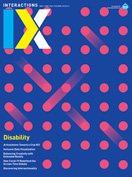Authors:
Seray Ibrahim, Asimina Vasalou
Consider the following scenario: Grace is a 9-year-old child who communicates using body movements, vocal sounds, and a paper-based book with graphic icons. Two years ago, her teachers and therapist assessed her abilities to use an electronic communication aid, and consequently issued her a high-spec, eye-gaze-enabled, speech-generating device. To date, she mostly uses this with her teachers to respond to rehearsed topics during class. Despite everyone having high hopes and fighting hard to fund the device, Grace isn't keen on it and chooses to use other modes instead. This scenario is all too common in designing for disability and…
You must be a member of SIGCHI, a subscriber to ACM's Digital Library, or an interactions subscriber to read the full text of this article.
GET ACCESS
Join ACM SIGCHIIn addition to all of the professional benefits of being a SIGCHI member, members get full access to interactions online content and receive the print version of the magazine bimonthly.
Subscribe to the ACM Digital Library
Get access to all interactions content online and the entire archive of ACM publications dating back to 1954. (Please check with your institution to see if it already has a subscription.)
Subscribe to interactions
Get full access to interactions online content and receive the print version of the magazine bimonthly.






